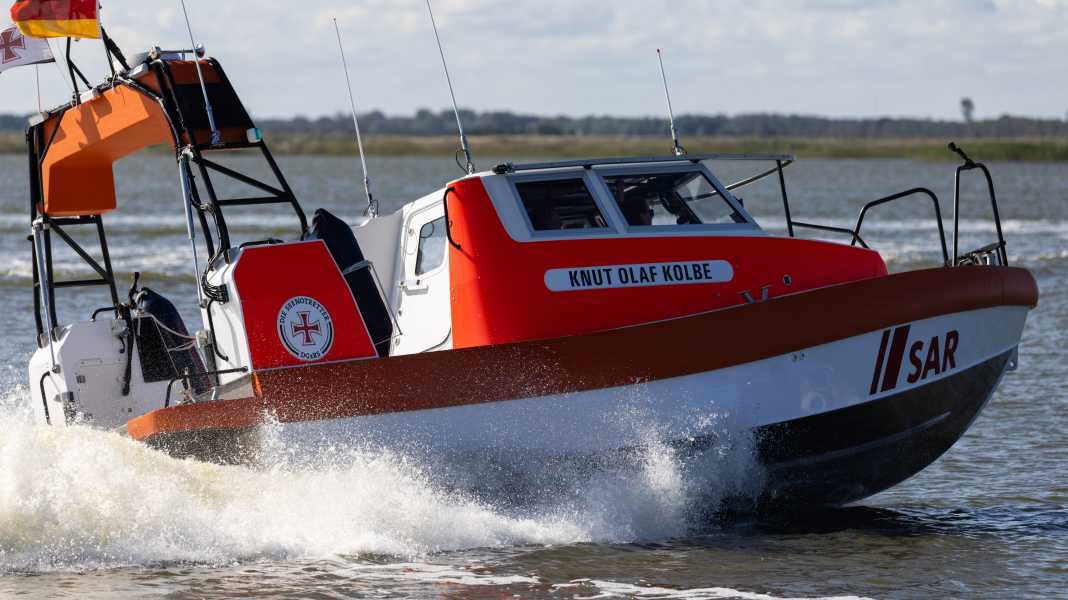
- A strong team for a special area of application
- What criteria characterise the 8.4 metre class
- Travelling by tractor into the Baltic Sea
- The cradle of German sea rescue lies on the Darß
- Regular modernisation of the rescue fleet
- Sea rescue in the cradle
- The basis of sea rescue: comradeship and appreciation
At full throttle, the "Knut Olaf Kolbe" heads for the shore. At the last moment, foreman Conrad Buchholz performs a "crash stop". The boat dips briefly with the bow and comes to an immediate halt. From 35 to 0 knots in one second. The force that would be expected in the cabin during such a manoeuvre does not materialise. Buchholz, who as the captain of a cruise ship does not normally get to enjoy such manoeuvres, grins: "It's great fun. Here on the calmer waters of the Bodden, the boat can show what it can do." The "Knut Olaf Kolbe" is the first rescue boat in the new 8.4 metre class of the German Maritime Search and Rescue Service (DGzRS). The propeller-less boat, equipped with a 425 hp jet drive, will gradually replace the 7-metre class. In future, the stations in Zingst and Zinnowitz on Usedom are also to be equipped with this new type.
A strong team for a special area of application
It has been in operation at the volunteer station in Wustrow since the end of last year. It is located at the narrowest point of the Fischland peninsula and places special demands on the crew and rescue unit due to its geographical location: the Wustrow sea rescuers operate both on the open Baltic Sea and on the back waters of the Bodden.
"On the one hand, we have the Baltic Sea with the Kadet Channel, one of the most difficult and dangerous sea areas in the Baltic Sea and one of the busiest sea routes in Europe with around 63,000 transits per year," explains Buchholz. "Here we work closely with the rescue cruisers "Nis Randers", which is stationed at the new island harbour in Prerow, and the "Arcona" from Warnemünde. Especially when it comes to towing distressed vessels. We are often on site first, secure the vessel, provide first aid and then hand it over to the large cruisers, which then tow the damaged boats to Warnemünde or, in future, to Prerow. And on the other side we have the Bodden, which with its shallow waters is also not an easy sailing area."
What criteria characterise the 8.4 metre class
This is precisely why the "Knut Olaf Kolbe" was designed by Arctic Airboats in Finland in close cooperation with the sea rescuers. Five years before the prototype of the new sea rescue boat, then still known as the SRB 85, went into service, the first considerations were made as to what challenges the new class would have to meet. The area of operation requires special mobility. Unlike at many other stations, the boat is not already more or less ready for use at a harbour, but has to be brought quickly from the rescue shed in the centre of Wustrow over the dyke to the beach and then transported overland to the Boddenhafen.
We need a boat that also works in shallow waters and can sail onto the beach without any problems."
"We need a boat that also works in shallow waters and can sail onto the beach without any problems," explains Conrad Buchholz. The 8.4-metre class has a draught of just 60 centimetres and, like all DGzRS rescue units, it has a high-strength aluminium hull. It can be used in all weathers, is characterised by high seaworthiness and can withstand heavy groundings and impacts.
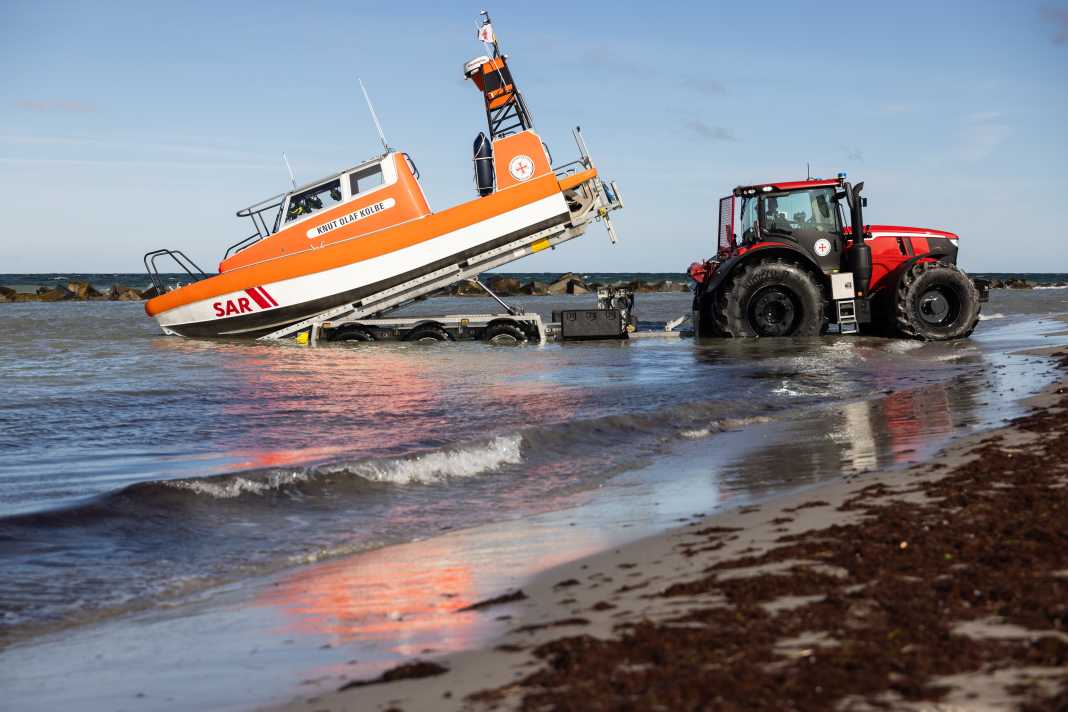



Travelling by tractor into the Baltic Sea
However, as the new boat is larger and heavier than its predecessor, a new special trailer with a third axle was required, which also added weight. Tests on the beach, in which the additional weight was simulated with concrete slabs, showed at the beginning of the construction phase that the towing vehicle at the time, a Unimog, would no longer have been able to pull the boat and trailer through the sand. So a new towing vehicle was also needed.
The "Knut Olaf Kolbe" is pulled by a John Deere 6R 230 tractor specially converted for maritime use. The 9.5 tonne tractor has been made "wadeable" for the special requirements on the beach. With its 280 hp six-cylinder engine, it can drive into the Baltic Sea water down to a depth of one metre. And thanks to the special trailer, "beaching" literally works without a hitch: the tractor-trailer combination reverses into the water, then the trailer is tilted and the boat slides into the water on rollers. Getting it back onto the trailer is a little trickier. This is because the boat, equipped with a water jet drive powered by a Cummins inboard engine, has to be driven onto the beach at high speed, then turned with a strong cable winch and pulled back onto the trailer.
"Basically, we're one of the few stations that still do it very traditionally, launching the boat into the water on the beach," explains foreman Conrad Buchholz. "The only difference is that today we use tractors and trailers instead of horse and cart."
The cradle of German sea rescue lies on the Darß
The rescue centre in Wustrow is one of the oldest on the German Baltic coast. The first sea rescue station in the Grand Duchy of Mecklenburg-Schwerin was established here as early as 1847, 18 years before the DGzRS was founded. Over the decades, the sea area between Rostock and Stralsund, and the Fischland-Darß peninsula in particular, developed into a popular tourist destination and leisure boating increased. For this reason, two of the DGzRS's three mobile units were set up in Wustrow and Zingst, which can be deployed across all waters (the third is located in Zinnowitz/Usedom).
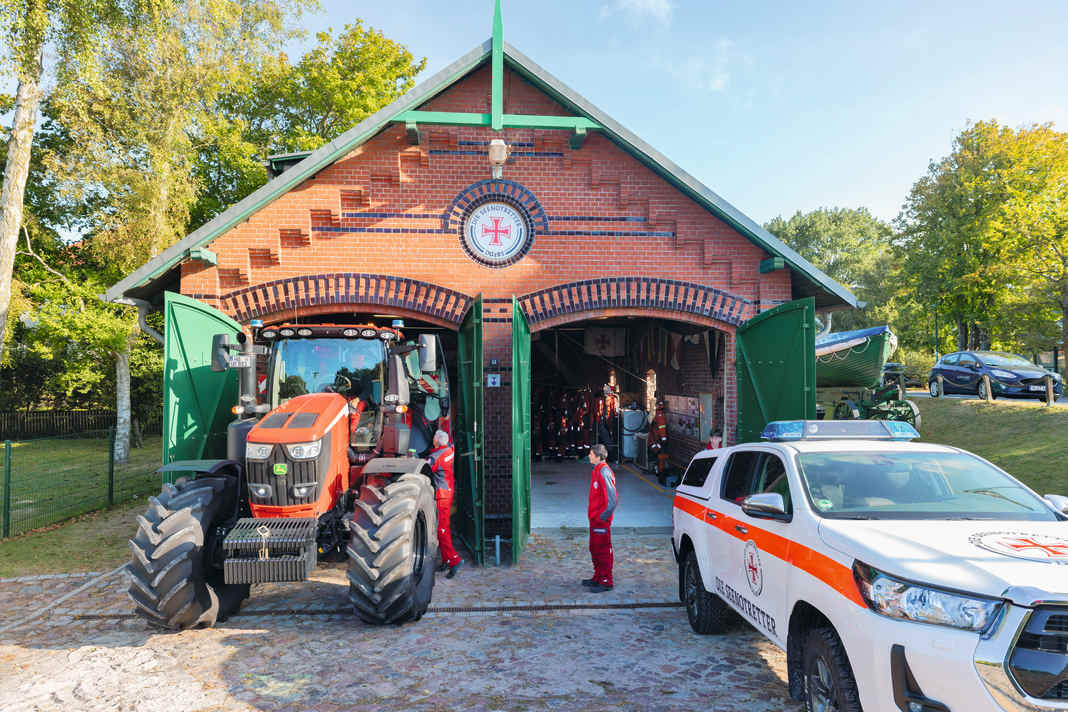


When the impressive vehicle leaves the historic rescue shed from 1905, it is a matter of centimetres on all sides. If the crew has only planned a practice run - as is the case today - this is not a problem. But when an emergency call comes in, sometimes every minute counts. That's why it's so important to get every move right. After the new lifeboat was put into service in December 2023, the crew went out to practice almost every weekend, even in the depths of winter, so that every crew member could familiarise themselves with the new boat and the procedures.
Regular modernisation of the rescue fleet
The new acquisition was necessary because its predecessor, the 7-metre "Persch" lifeboat, was getting on in years. The DGzRS applies the "60-30-2" formula: there are 60 units, which are usually in service for 30 years. This means that there have to be two new builds per year in order to keep up with the renewal of the fleet.
Jörg Westphal, the longest-serving employee at the station in Wustrow, remembers some of the challenges that the new building brought with it: "Our old towing vehicle, the Unimog, was actually more practical than the new tractor, as it could be used to transport the entire crew. We only needed one driver for the Unimog. Now, in addition to the tractor driver, we need an extra driver for the pickup, which had to be purchased to drive the crew to the scene in their protective suits." In the meantime, however, the 18-strong team of volunteer sea rescuers has settled in well. They live and work around the station, are at the rescue shed within a few minutes of being alerted, occupy the towing vehicle and crew transport vehicle and set off on their mission.
Sea rescue in the cradle
One of them is Sandra Priebe, a nurse with the volunteer fire brigade and an official crew member since 2018. Unofficially, she has been part of the "sea rescuer family" her whole life. Her father was the station foreman in Wustrow for 25 years. She was the one who christened the predecessor "Perch" back in 1993. She was born into the sea rescue business, so to speak. "When the red rockets flew and the signal came, we children always ran after them and watched." So it's not surprising that her sister and son are also part of the crew alongside her. When her beloved "Perch" and the Unimog U2150L went into well-deserved retirement at the Unimog Museum in Gaggenau in Baden-Württemberg last year, there was hardly a dry eye in the house. "That was really emotional. We grew up with the 'Perch'. And it served us faithfully until the end."
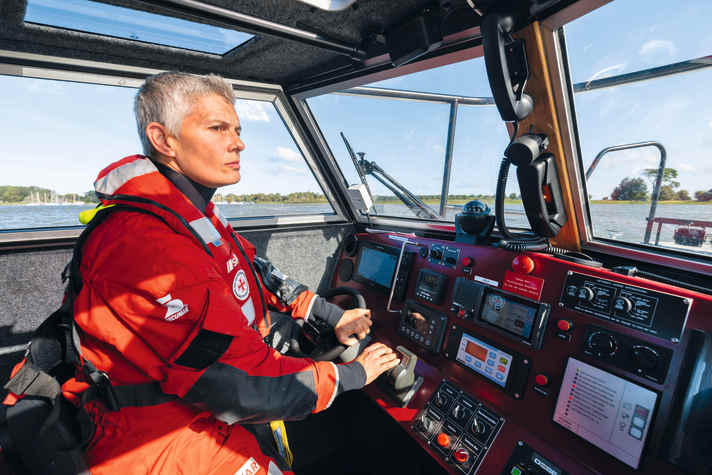
But despite all the sentimentality, when the "Knut Olaf Kolbe" arrived, the joy of the new technology prevailed. "There's a clear difference in the way we sail," reports Priebe. "The "Perch" was very tippy. You had to pay close attention to the load distribution. You couldn't have two heavy people on the left and two light people on the right. And manoeuvres like the ones we are now doing with the new boat would not have been possible with the "Perch".
The 8.4-metre class is not only faster, but also much more agile, manoeuvrable and stable"
When the "Knut Olaf Kolbe" ploughs through the waves of the Saaler Bodden at full throttle, you hardly feel the impact on the hull in the cabin thanks to the cushioning of the seats.
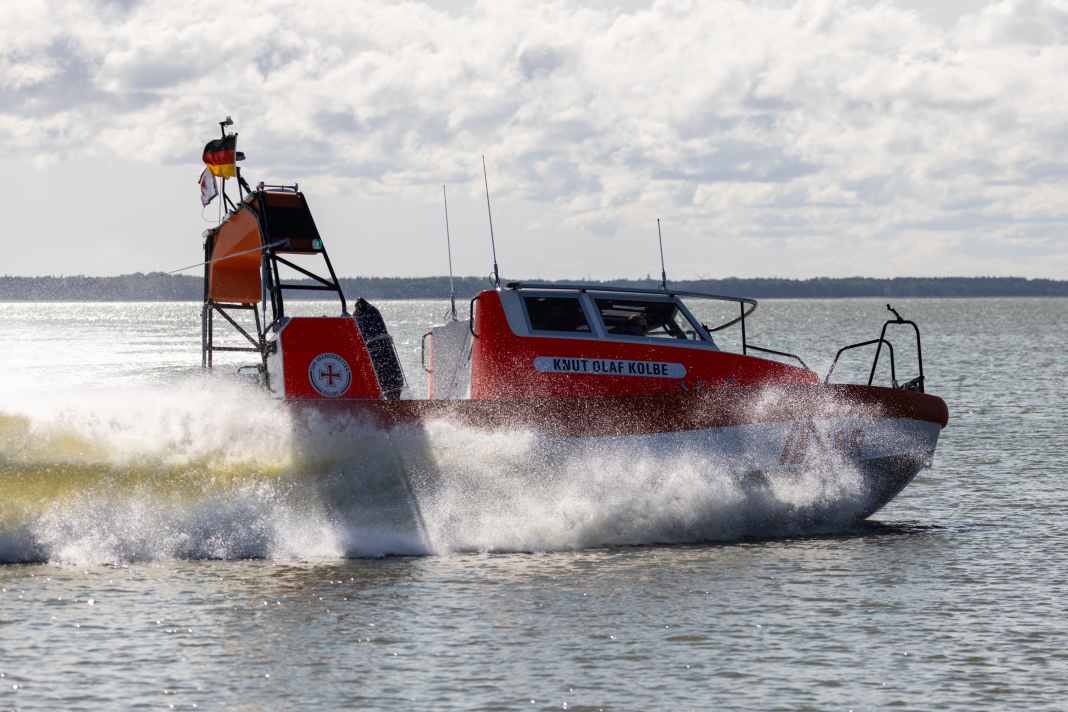


The basis of sea rescue: comradeship and appreciation
The Bodden is very shallow in many places. Most of the 40 or so operations per year are carried out by the Wustrow team because of "fixed-roaders". They tow them away or provide technical assistance. More and more frequently, however, they also rescue exhausted kiters. The regularly medically trained sea rescuers are prepared for all possible cases. When the emergency call is received by the Maritime Rescue Co-ordination Centre (MRCC) in Bremen, the crew often does not yet know what to expect. A search operation on the Baltic Sea can sometimes take hours and be nerve-wracking. But every single one of them is passionate about their work.
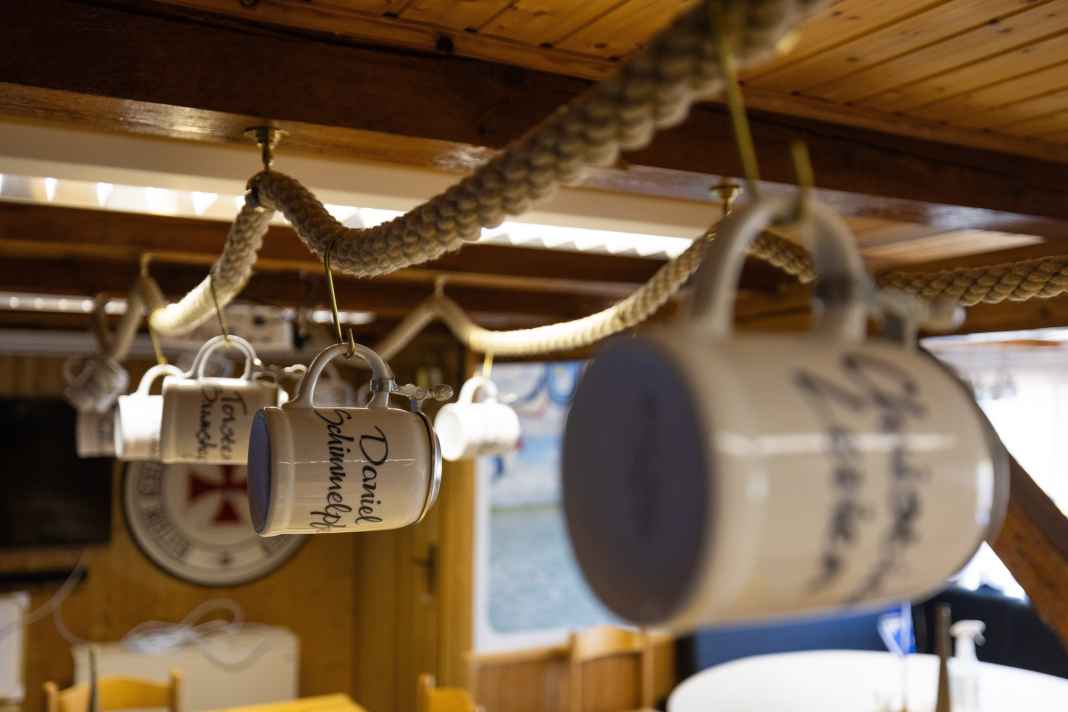


One glance into the common room of the rescue centre is enough to realise that this is more than just a loose association of volunteers. Beer mugs dangle from the ceiling, labelled with each member's name and the year they joined. Portraits of former members hang on the wall. A lot has changed since its beginnings in 1987, recalls Jörg Westphal. "Especially after reunification, when the DGzRS took over again and we were equipped with new technology, life jackets and survival suits. Of course, many things are very different today. But what has always remained is the camaraderie."
Most of the sea rescuers are volunteers and their work and the necessary equipment is still only made possible by voluntary donations. The new construction of the "Knut Olaf Kolbe" was made possible because a couple from Hanover had stipulated in their will that a substantial part of their estate be donated to the DGzRS. According to Conrad Buchholz, it is also this appreciation that motivates people to stay involved: "It is always touching when someone supports our work and helps us to help people in distress at sea with their donation."

